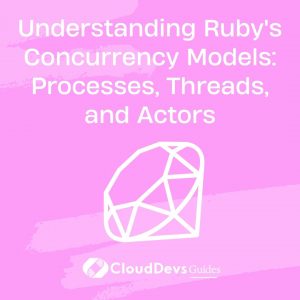Understanding Ruby’s Concurrency Models: Processes, Threads, and Actors
In the world of programming, concurrency plays a vital role in improving the efficiency and performance of applications. Concurrency allows programs to execute multiple tasks simultaneously, taking full advantage of modern multi-core processors. Ruby, a dynamic and versatile programming language, offers several concurrency models to achieve parallelism: processes, threads, and actors. In this blog post, we will delve into each of these concurrency models, understand their nuances, and explore code samples to illustrate their usage.
Table of Contents
1. Introduction to Concurrency Models
Concurrency is the ability of a system to execute multiple tasks concurrently, making the most of available resources. Ruby, being a language focused on developer productivity, offers multiple concurrency models to cater to different scenarios. These models are processes, threads, and actors. Understanding their differences is essential to select the appropriate model for your application’s requirements.
2. Processes: Isolated Execution Environments
Processes are independent execution units with their memory space, resources, and state. They offer a high level of isolation, making them suitable for situations where fault tolerance and separation are critical.
2.1. Creating Processes
Ruby’s Process module provides methods to create new processes. Each process runs independently, allowing parallel execution of tasks. Here’s a simple code snippet:
ruby # Creating a new process pid = Process.fork do puts "Child process: Hello from child!" end # The parent process continues here if pid Process.wait(pid) puts "Parent process: Child process is done." end
2.2. Inter-Process Communication
Processes can communicate through various mechanisms like pipes, sockets, and shared memory. Here’s an example of using pipes for communication:
ruby
reader, writer = IO.pipe
Process.fork do
writer.close
reader.puts "Message from child process."
end
reader.close
puts "Parent process received: #{reader.gets}"
3. Threads: Lightweight Parallelism
Threads are lighter-weight than processes, as they share the same memory space. They are suitable for tasks that involve I/O-bound operations or parallelism without the need for strict isolation.
3.1. Creating Threads
Ruby’s Thread class enables thread creation. Here’s a basic example:
ruby
# Creating threads
thread1 = Thread.new { puts "Thread 1: Hello from thread!" }
thread2 = Thread.new { puts "Thread 2: Hello from thread!" }
thread1.join
thread2.join
3.2. Thread Safety and Synchronization
Since threads share memory, concurrent access to shared resources can lead to data corruption or race conditions. Ruby offers synchronization mechanisms like Mutex, ensuring only one thread accesses critical sections at a time:
ruby
counter = 0
mutex = Mutex.new
# Updating shared counter safely using a mutex
threads = Array.new(10).map do
Thread.new do
mutex.synchronize do
counter += 1
end
end
end
threads.each(&:join)
puts "Counter value: #{counter}"
4. Actors: Managing Concurrency through Isolation
Actors are a higher-level concurrency model introduced by the “Celluloid” gem. They provide isolation by encapsulating both state and behavior, communicating only through message passing. This model is suitable for systems requiring high concurrency and easy management of parallel tasks.
4.1. Implementing Actors
First, install the “Celluloid” gem:
bash gem install celluloid
Now, let’s create a simple actor:
ruby
require 'celluloid'
class MyActor
include Celluloid
def initialize
@counter = 0
end
def increment
@counter += 1
end
def get_counter
@counter
end
end
# Create an instance of the actor
actor = MyActor.new
# Communicate with the actor using messages
actor.async.increment
actor.async.increment
puts "Counter value from actor: #{actor.get_counter}"
4.2. Message Passing and State Isolation
Actors communicate exclusively through messages, which ensures that their state remains isolated. This approach prevents data corruption and simplifies concurrent programming. Here’s an example:
ruby
class MessageActor
include Celluloid
def initialize
@messages = []
end
def add_message(message)
@messages.push(message)
end
def get_messages
@messages.dup
end
end
message_actor = MessageActor.new
message_actor.async.add_message("Hello from message 1")
message_actor.async.add_message("Hello from message 2")
puts "Messages from actor: #{message_actor.get_messages}"
5. Choosing the Right Concurrency Model
Selecting the appropriate concurrency model depends on your application’s requirements. Use processes for high isolation and fault tolerance, threads for lightweight parallelism, and actors for managing concurrency through encapsulation.
Conclusion
Ruby’s concurrency models – processes, threads, and actors – offer different ways to achieve parallelism and handle concurrent tasks effectively. Understanding the strengths and weaknesses of each model is crucial for designing robust and high-performance applications. By choosing the right concurrency model based on your application’s needs, you can harness the power of parallel programming in the Ruby programming language.
Table of Contents








